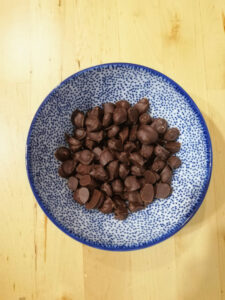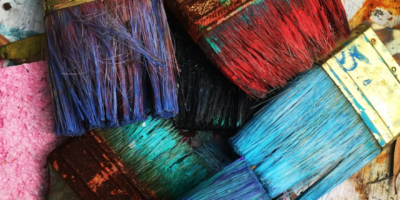Most students are no stranger to the taste of a bad cup of coffee. As someone who recently started drinking their coffee black, it’s taken me a few tries to get the brewing process right and move away from bitter watery bean juice. While hastily-brewed coffee can be drowned in cream and sugar to be made palatable, I wanted to indulge my inner coffee snob, enjoy coffee for what it’s supposed to taste like and learn more about the science that goes into growing a good tasting cup from the ground up.
Scroll to the bottom of the page for a recipe for chocolate-covered coffee beans.
Bean Basics
First, some bean basics. Coffee cherries are the fruit of the coffee plant, containing a pit of coffee beans. When the cherries ripen to a bright red, they are picked, processed, and roasted to varying degrees. The anatomy of a coffee cherry includes the pulp of the fruit, the seed (split into two halves, the familiar coffee bean shape), as well as a parchment skin surrounding the seed, and a layer of mucilage holding it together. There are a variety of surprisingly scientific factors surrounding the growth and processing of these coffee cherries that affect the flavours of the resulting brew.
There are two main kinds of coffee plant: arabica and robusta. Arabica beans have more of a fruity acidic taste, while robusta tends to have a stronger, more bitter flavour. Robusta also contains 40-50% more caffeine, and is generally cheaper due to the less intense growth conditions required; arabica beans are more susceptible to pests and disease, take multiple years to produce fruit, and yield less fruit than robusta plants.
The region coffee is grown imbues a distinct taste of the place into the brew, known as terroir in reference to the chemical differences in coffee-growing soils and their effects on flavour. Along with the soil quality, terroir is affected by the climate and altitude at which the plant grows.
The best kind of soil for growing coffee is volcanic soil, which contains a ton of minerals, and provides good drainage, which allows the plants to more effectively access and utilize the nutrients in the soil. These make for a cup of coffee with better body and acidity.
Most coffee is grown along the equator between the Tropics of Cancer and Capricorn in what is known as the Bean Belt. Within this belt, there are a variety of microclimates- sheltered regions that differ from the surrounding climate, which often produce optimal conditions for growing delicious coffee. Hand-in-hand with good drainage is the need for distinct dry and rainy seasons; rain brings about growth and nutrient acquisition, while a dry season is needed to keep the beans in good shape during harvest, as well as prompt flowering and new fruit growth.
The altitude at which a coffee plant is grown also affects the terroir of the coffee produced. The lower temperatures at higher altitudes force plants to slow growth, diverting more energy into reproduction and producing better quality beans with a greater concentration of sugars and flavourful nutrients. The more sought-after beans are grown at very high altitudes (greater than 5000 feet) and have fruity, floral, and acidic notes. High altitudes (around 4000 feet) can have chocolatey, nutty, citrus, and vanilla notes. As the altitude decreases, the flavour of the coffee becomes more subtle, smooth, simple, and bland.
However, terroir is not the most important factor affecting taste. After the cherries have been picked, a variety of processing procedures can make a total difference in the flavour of the final brew.
Cherries are processed in one of two ways. The dry method is the oldest method and the most widely used, in which the fruit is laid out in the sun and left to dry over a period of weeks, raked around, and covered at night to prevent moisture from returning. The wet method involves first removing the pulp, then passing the seed pods through water channels, fermenting them to remove the mucilage layer, and laying them out to dry.
The dry method tends to produce beans with more fruity and fermented flavours, as the coffee beans dry inside the cherry and are able to absorb more of the natural sugars in the fruit, while the wet method produces a more clear and fresh-tasting coffee. Both methods involve drying the beans until they have about 11% moisture remaining, then the beans are ready for further processing.
Beans are hulled to remove remaining pulp and parchment, then graded and sorted based on size, weight, shape and colour. The bean size scale represents the size of a bean from 10 to 20, as measures of 1/64”. For example, a number 20 bean measures a 20/64” diameter. Once all the defective beans have been removed, the so-called green coffee is ready for roasting.
The process of roasting coffee is when all the flavours and aromas are released. The longer the coffee is roasted, the darker the roast. A darker roast has more oils rise to the surface during cooking, producing a more rich, spicy, and burnt flavour. Unintuitively, darker roasts actually have slightly less caffeine as a small amount will burn off during the roasting process.
While a freshly brewed cup of coffee in the morning is unbeatable, sometimes you need a pick-me-up and a beverage doesn’t feel quite right. If you still want to make use of your favourite specialty beans, make a coffee that you can snack on throughout the day.
Chocolate-Covered Coffee Beans
Despite their appearance, these mocha nibbles are delicious and are fairly simple to put together. It may seem like overkill to individually dip each bean, but it’s worth the process. I made a batch, ate nearly all of them, then made another batch while still wired from the caffeine hit. They’re a great study snack or a midday pick-me-up. Good luck not eating three cups of coffee in one go.
Ingredients
- ½ cup coffee beans (preferably a darker roast)
- ½ cup chocolate chips
- 1 tbsp butter
- Cocoa powder (optional)
Recipe
- Preheat the oven to 350°F.
- Bake the coffee beans for around 10 minutes. Let cool.
- Put the chocolate chips and butter in a microwave-safe bowl and microwave for 30s intervals, stirring in between until the chocolate is melted and smooth.
- Lay parchment paper on a flat surface.
- Individually dip each bean into the chocolate and lay them on the parchment. You can use two spoons or even your (clean) fingers to make this easier.
- Put in the fridge to set for at least half an hour.
- Repeat step 5 until you reach your preferred level of chocolate.
- (Optional) Roll some or all of the beans in cocoa powder.
- Enjoy chilled.
The Finished Product


Sources
https://www.ncausa.org/About-Coffee/10-Steps-from-Seed-to-Cup
https://www.thekitchn.com/coffee-basics-the-difference-b-41949
https://perfectdailygrind.com/2015/06/how-does-altitude-affect-coffee-and-its-taste-in-the-cup/
https://perfectdailygrind.com/2018/03/what-is-terroir-and-how-does-it-affect-your-coffee/





Leave a Reply